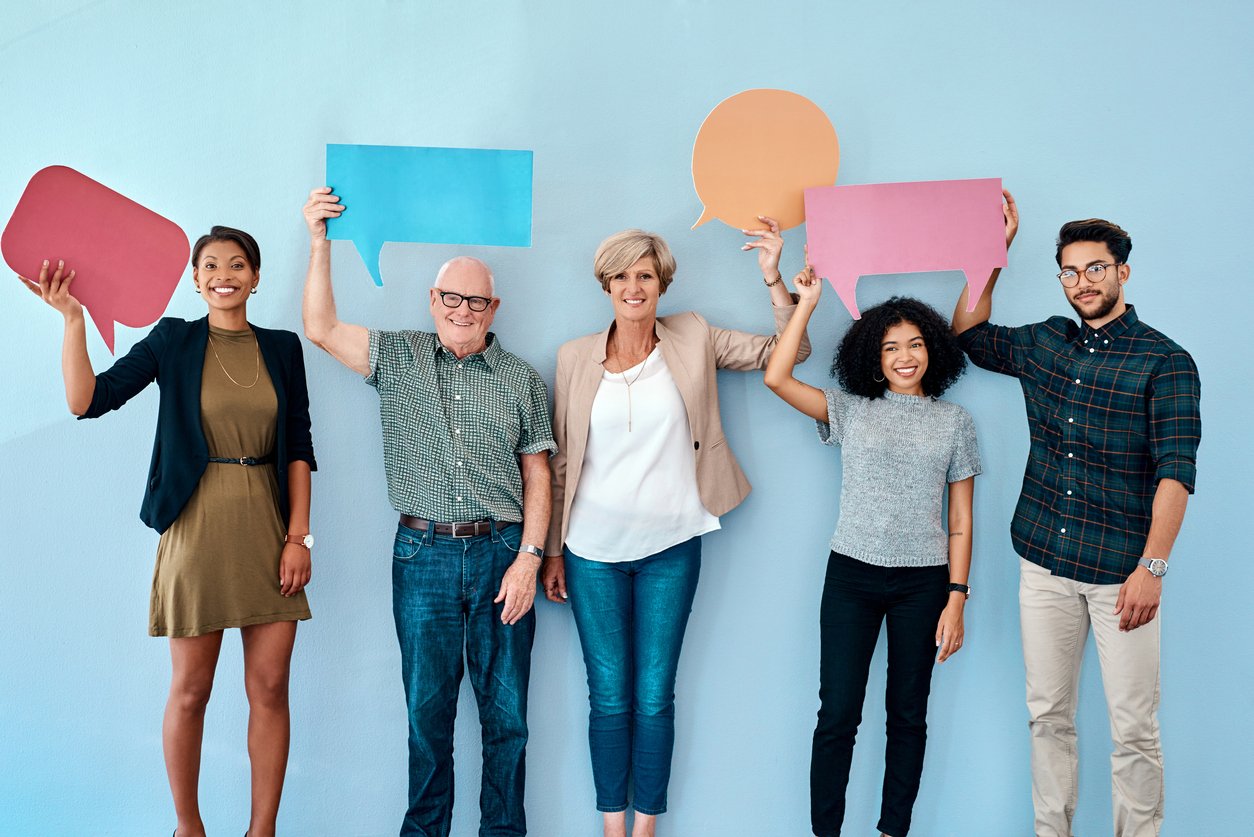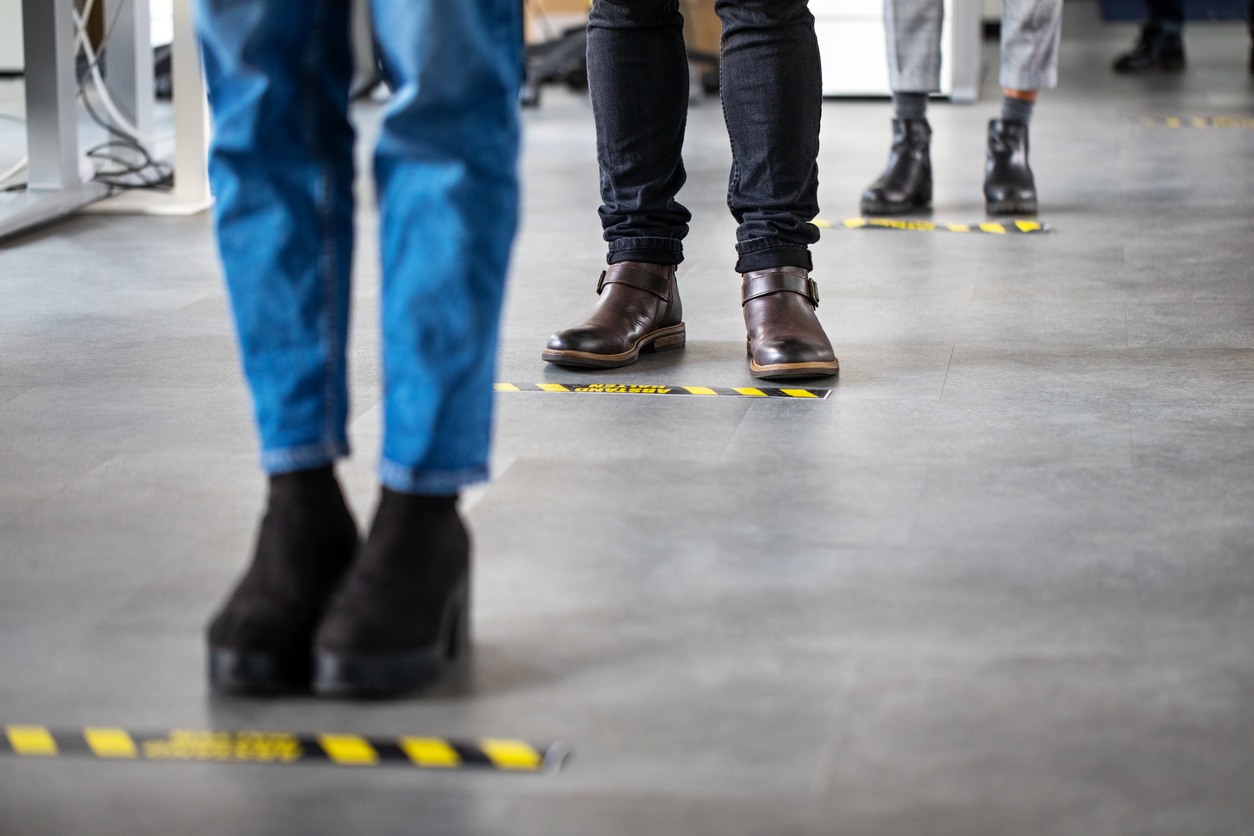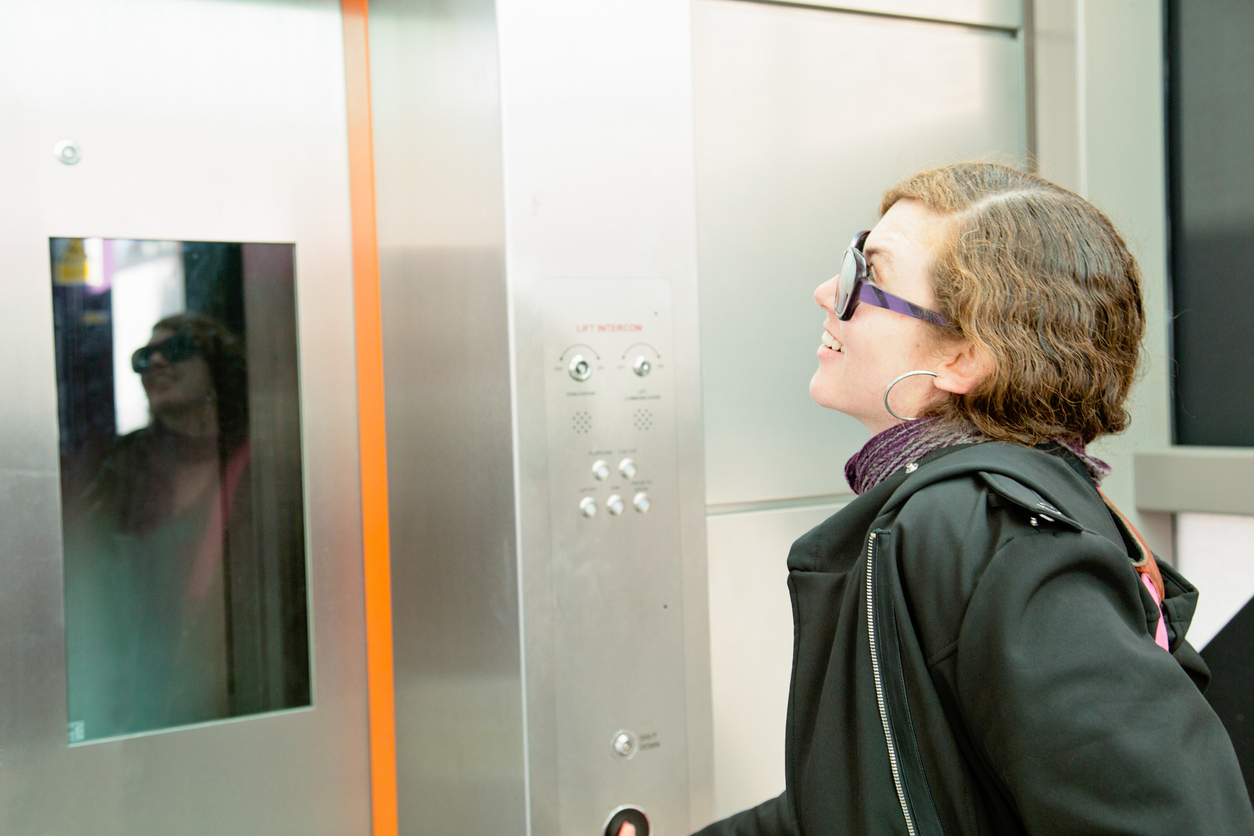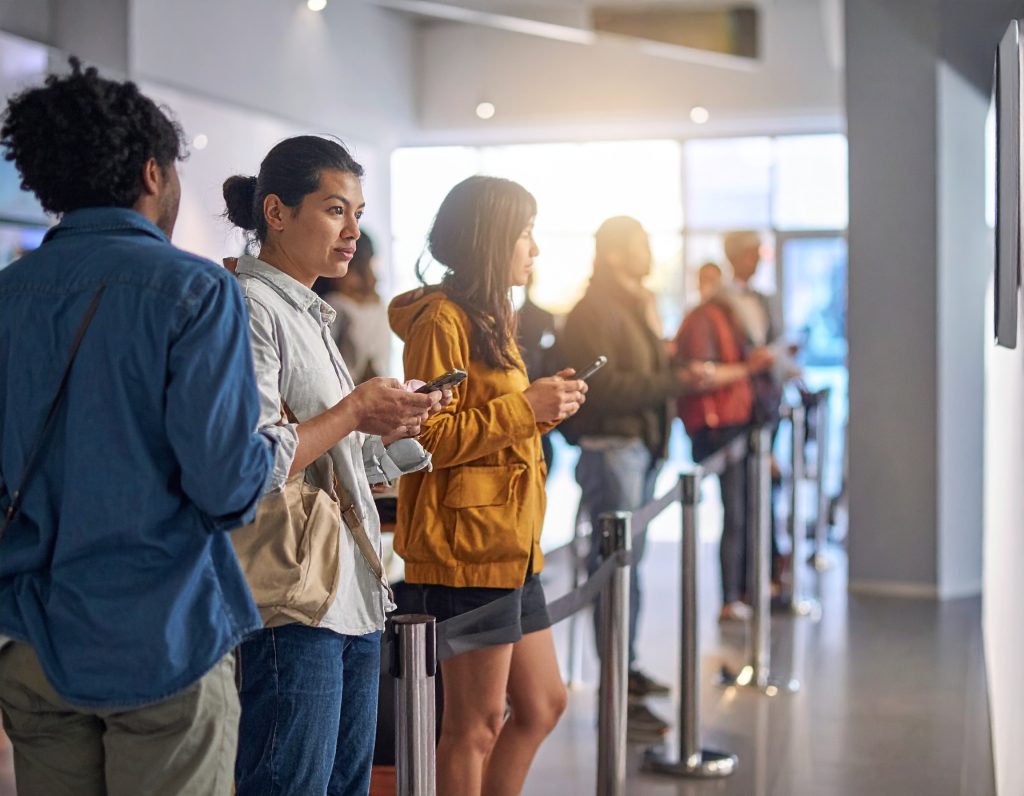How Queuing Theory Systems Can Help Improve Customer Experience

6 Feb 2023
Queuing is an essential part of life.
For someone camping overnight for the latest iPhone, waiting in line is a thrilling experience.
For a family with small children waiting to check-in for their flight, it’s a mind-numbing nightmare.
Whether we like it or not, we wait in line for something at least every week.
While customers try to find the fastest wait time possible, businesses must implement strategies and processes to improve the queuing experience and keep customers coming back.
Depending on the queue management systems they have in place, queuing can either make or break a business’s success.
When managed effectively, businesses can dramatically improve customer experience and boost brand loyalty with their queue.
But, without supportive queue management processes, businesses put themselves, their staff, and their customers at risk.
We’ll be diving into the definition of queuing and how businesses can use queue theory to their advantage. Let’s get started.
Define “Queuing”
What is a queue?
Waiting in line has become so common and widely accepted that people rarely stop to consider how often they queue for things, and what those queues look like.
By the time we reach adulthood, most people have experienced at least 5 types of queue:
| Type | Definition | Example |
| Serpentine | A single line that zig-zags towards several service desks. When the customer reaches the front of the line, they are called to an available service desk. | Movie theatres, airports, and banks. |
| Multiple lines | When a customer arrives, they must choose between multiple lines for multiple service desks. | Fast food restaurants and supermarkets. |
| Phone queues | A customer calls a business. They are told their place in the queue and listen to “on-hold” music until a representative is available to take their call. | Customer service departments, government agencies, telecommunications services. |
| Waiting rooms | A customer arrives for an appointment and must wait in a room with other customers until they are called. | Healthcare providers. |
| Online multiplayer games | Gamers must wait for other people to join the game and for the graphics to load before the game starts. | Call of Duty, Overwatch, and Fortnite. |
It seems to be an obvious question. But, when was the last time you stopped and wondered why it’s second nature for us to wait in line?
Black Friday sales aside, everyone knows how to “form an orderly queue”.
Picture a man visiting a store, restaurant, government agency, or healthcare provider. All the front desk staff are busy serving customers. Several other people can’t be served right now, either.
In most cases, the man doesn’t barge into the front of the line and demand to be served. But he doesn’t shrug and leave the store, either. Instead, it’s perfectly reasonable for the man to join the queue with the other customers and patiently wait for his turn.
Knowing how to wait in line has been socially ingrained into most of us since childhood. Our queue experiences could be some of our best and worst memories.
Many people take pride in waiting for something and will happily spend hours – or even days – queueing to buy the latest iPhone, sneaker, tickets, or even book.
Others have been left shocked and upset by their waiting experience, like this family who missed their one week holiday because their coach was 2 hours late.
As a customer, it’s important to make observations and choices that minimize the amount of time we spend waiting for things. Doing so helps us live more positive lives and get the most out of our free time.
As a business, it’s critical to find ways to shorten and improve the waiting experience for customers. Failing to do so risks damage to reputation, fewer sales, and losing customers to competitors.
The Psychology Of Waiting
It might surprise you to know that some people have made a career studying queues.
That’s right, there are academic departments, fields of research, and enough theses to fill a library – all dedicated to the study of waiting.
When you think about it, there are numerous approaches you could take to researching the queueing phenomenon:
- Historical – where do queues come from?
- Sociological – what do queues and queuing behaviour say about society?
- Statistical – how many people queue, how often, for what, in what location, etc.
- Psychological – how do queues influence human behaviour?
The psychology of queueing is highly valuable to businesses.
With knowledge of how queues influence customers’ experience and perception of a business, businesses can make informed decisions that ultimately lead to greater success.
With that in mind, it’s important to be familiar with the leading minds in the world of queue theory.
Introducing “Dr. Queue”
At least, that’s the name affectionately attributed to MIT professor, Richard Larson. He’s the master of queue research whose theories have made him world-famous.
Dr Richard Larson is the leading voice on queue theory, teaching businesses around the world how their approach to customer wait times can either make or break their success.
In a famous article in The Washington Post, Larson lays down the foundations of his research. His theories, among the research from other queue experts, help to provide businesses with the tools they need to create positive waiting experiences.
The Four Theories of Queuing
The research of Dr Larson, along with other experts, can be summarized into 4 main queue theories:
| Theory | Definition | Example |
| Perceived wait time > actual wait time | People prefer a longer but more entertaining wait time to a short yet boring one. | Standing in line for 20 minutes with zero visual, audial, or physical stimulus is far more unpleasant than sitting in a comfortable waiting room for 35 minutes with a selection of interesting magazines and enjoyable music – or, even, a coffee. |
| Unfairness leads to queue rage | People quickly become anxious, frustrated, and even aggressive when they see people who arrived before them be served first. This is because the situation seems unfair. | At the supermarket, customers must often choose between several lines, and select the one they think will serve them the quickest. But, if they see someone in another line be served quicker, even though that person arrived later, they can become enraged because it doesn’t seem fair. |
| Queue tolerance is proportional | A person’s tolerance for wait time is directly proportional to the number of items they are buying or the complexity of the service they require. | If someone has a cart full of groceries, they are more tolerant of a long wait time than someone who is just purchasing milk. |
| Overall wait experience = how it ends | Studies show that a person’s overall waiting experience is defined mostly by what happens at the end. A long wait with a pleasant ending is more preferable than a shorter wait with an unpleasant ending. | Two people wait in separate lines at McDonald’s. The first person’s line moves quickly at first but then slows down to a crawl until the first person is served. The second person’s line starts slow, but gradually quickens until they are served. Even though they waited for an equal amount of time, the second person had a more pleasant experience. |
What’s most interesting about these theories is that they might seem complicated at first. But, when you think about it, you’ve probably had a queuing experience that fits into one of each category.
Because queuing is such a common occurrence, research into queuing theory is practical and relatable to everyone – customers and business owners alike.
How Queues Affect…

Your Business
If your business is crowded with customers regularly, you probably feel proud because it shows how popular your product or service is with customers.
However, the experience your customers have while waiting for service is going to have a huge impact on your success.
Here are 4 business problems caused by unnecessarily long wait times and a poor queuing experience:
- Loss of brand loyalty
- Fewer sales
- Less competitive offering
- Compromised customer safety
Firstly, businesses risk losing loyal customers if they fail to manage their queuing experience. This means that if customers lose too much of their free time while waiting for your services, they’ll be less likely to choose your business again in the future.
By putting customer loyalty at risk, businesses will ultimately lose sales as more customers choose to shop elsewhere. It’s also possible that customers who have a negative waiting experience will buy fewer items or services from your business. If you fail to address queue management, your business will get a bad reputation for queuing and lose new customers as well, further reducing potential sales.
For a business to be competitive, it’s essential to address the queuing component of your service offering. If one of your competitors boasts a more positive queuing experience with less wait time, your customers will soon jump ship. Even if you have the best product or service on the market, a terrible waiting experience reduces your business’s value.
As COVID-19 has caused over a million deaths worldwide, businesses must enforce social distancing rules to keep people safe and continue to operate during a global pandemic. If your business fails to address overcrowding and queue management, you’re putting your community at risk, and you could be shut down by the government.
Your Employees
The performance of your employees plays a critical role in a customer’s experience with your business. But, if your business neglects queue management, you’ll create a toxic work environment for your employees.
Here are 3 reasons why:
- Queue rage
- Pressure
- Feedback
Imagine having to serve a queue of angry, frustrated, and aggressive customers who are complaining about having to wait in line. It’s not the employee’s fault, yet it’s their responsibility to make your customers happy and diffuse the situation. If this is happening regularly, it harms staff wellbeing and greatly affects their performance, and that’s if they continue to work for you.
Unmanaged queues leave your staff with little chance to prepare for each customer interaction and have a short rest before serving the next customer. Long lines that aren’t managed properly create an intensely high-pressure work environment for staff, regardless of the customers’ behavior.
Your employees need to hear praise and constructive feedback to gain job satisfaction and improve their service to your customers. Without a queue management system in place, it’s almost impossible to track employee performance. This means your standard of service will either plateau over time or get worse as employees become complacent without feedback.
Queue System Success Stories
It’s clear that queues have a massive impact on a business’s ability to:
- Attract more customers
- Build brand loyalty
- Improve the standard of service
But what are the ways that a business can manage their queues and customer wait times, and what are the results?
Let’s walk through some famous examples of businesses who applied queuing theory to improve the waiting experience for their customers.
Elevators

The classic example of queuing theory in practice takes us back to when skyscrapers were first constructed in New York City.
Because the buildings were so tall, it took a long time for a person to reach the top floor from the lobby.
After receiving many complaints, architects modified the elevators in two ways:
- Mirrors were installed on one wall
- A floor indicator was installed to show progress
These modifications did nothing to reduce the overall wait time – you can’t safely speed-up an elevator and decreasing the number of floors defeats the purpose of a skyscraper.
But complaints were eliminated and the waiting experience was drastically improved. There are two reasons for this:
- Unoccupied wait time feels longer than occupied wait time
- Wait times feel longer and more frustrating when you can’t see progress
By installing mirrors and a mechanism to show progress up the skyscraper, people riding the elevator had something to look at and a way of knowing that their wait was paying off.
This is the simplest application of queue theory to improve the waiting experience and shows how the wait time doesn’t have to be reduced to increase satisfaction.
Disney World

It’s world-famous for two things: rollercoasters and long queues.
Going to Disney World is every child’s dream, but the prospect of long queues in the hot sun is every parent’s worst nightmare.
As a successful global business, Disney World was well aware that long, unmanaged queues posed a significant threat to customer loyalty and annual revenue.
To improve the waiting experience for both parents and small children, Disney World applied the following queuing theories to develop an effective queue management system:
- Unoccupied wait time feels longer than occupied wait time
- Angry, frustrated, and anxious wait time feels longer than a relaxed wait time
- Unfair waits feel longer than fair ones
- Unexpected wait time feels longer than expected wait time
To keep children in high spirits during the wait for their ride, Disney World created murals and shows where costumed Disney characters paraded throughout the queue as entertainment.
To reassure adults and improve their waiting experience, Disney World installed numerous screens at checkpoints to communicate the expected wait time.
An additional feature to the queue management system was an “ahead of schedule” update, which ensured customer satisfaction by presenting the perception that their queuing experience was above-average.
Disney World has become a useful case study for businesses looking to improve their queue management processes.
Queue Management Systems: Where Research Meets Technology
Software developers have used the latest research from experts like “Dr. Queue” to develop a solution that helps businesses improve the waiting experience for their customers.
Queue management systems take businesses to the next level by addressing and solving the problems caused by queues:
- Dissatisfied customers
- Stressed staff
- Compromised safety
- Poor business management
Customers hate waiting in line, especially if the wait time is boring and their movement is restricted. Queue management systems solve this problem by allowing customers to secure their spot in a virtual queue using their smartphone or on-site tablet.
Then, the customer receives a notification of their expected wait time, with consistent updates telling them how much longer they have to wait.
By digitizing the queuing experience, businesses allow customers to roam freely until it’s their turn to be served. Customers, therefore, have a positive waiting experience, and businesses can keep their premises clear.
Customers use their smartphone or on-site tablet to secure their spot in the queue, so they have to fill in their personal information and more details about their query. This gives your staff the chance to prepare for each interaction and deliver a more personalized and attentive customer service experience.
By implementing a digital queue management system, businesses can ensure that customers and staff are using social distancing, as well as making the customer experience as contactless as possible. This makes your business far safer and more accessible during a pandemic.
Queue management software doubled as a performance monitoring tool, which is a great asset to business managers. By collecting valuable data such as customer foot traffic, customer feedback, employee performance, revenue, and other more specific metrics, your queue management system can help your management team make informed decisions to improve and grow your business.
FA-Queues (Queueing Queries)

- How long do people spend waiting in line?
According to Richard Larson, the average American spends at least two years of their life waiting in line.
- What factors influence the queuing experience?
Customers use the following factors to determine the quality of their queuing experience: comfort, personalization, fairness, speed, and communication.
- What’s faster, a single-line queue or a multiple-line queue?
When they’re both operating efficiently, neither type of queue is faster. However, the single-line serpentine queue is more preferable to customers because it causes less stress by having all customers in one line.
- What is virtual queuing?
Virtual queuing is a digital queue that customers can access via a smartphone app or on-site tablet. Customers can receive push notifications of their progress in the queue and gain the freedom to entertain themselves while they wait. Businesses can implement numerous digital processes to improve efficiency.
- How can I make my waiting room more comfortable?
Implement the following: comfortable chairs, new magazines, pleasant music, air conditioning, coffee and confectionery machines.
- What are the best ways to keep customers entertained in the queue?
Artistic murals, TVs, exhibits, and free Wi-Fi.
- How can I encourage customers to buy more during their queuing experience?
Position shelves of small, popular products or place posters with marketing messages close to the queue, so customers who are waiting are more likely to buy more products or services.
- How can my customer service staff provide a better service to customers who’ve waited in line?
Make sure your staff: smile, greet your customer by name, thank your customer for waiting, make eye contact, and allow them the time to explain their query (even though they know what it’s going to be).
Conclusion: How Can Your Business Implement Queue Management?
If you’re ready to improve your customer experience with queuing, it’s time to evaluate which queue management system will best suit your business.
You might be a business that takes regular appointments, such as a hair salon or dentist. An online booking system will help you manage your customer appointments and appointment reminders with online automation.
If your retail store needs to manage customer traffic and social distancing to minimize the risk of infection, a system that creates a contactless experience and tracks customer movements will be perfect.
Or, you just need a platform to monitor and analyze customer behaviour and business performance. If that’s the case, a cloud-based queue management system will help you gain valuable insights to make more informed decisions for business improvement.
Skiplino has been developed to help businesses minimize customer wait times, improve the queuing experience, and give business owners the tools and strategies to improve and achieve their goals.
Talk to our team to find out how our software solution can take your business further.
Latest



Similar Reads


All Rights Reserved @2025 Skiplino Technologies WLL.




